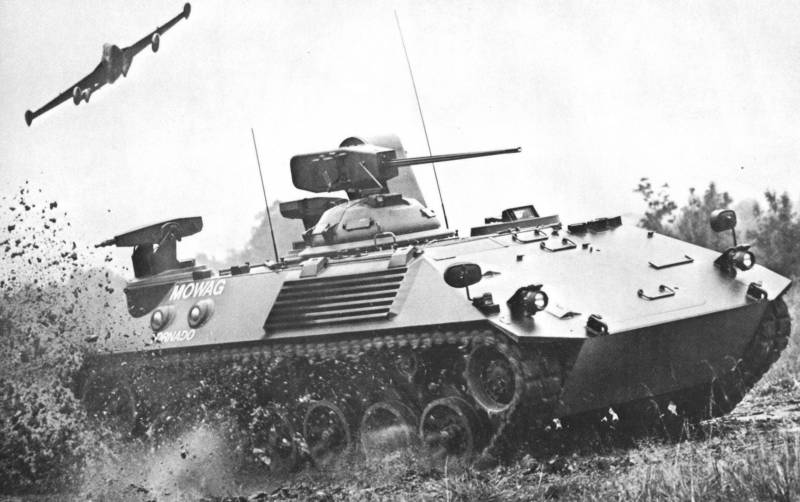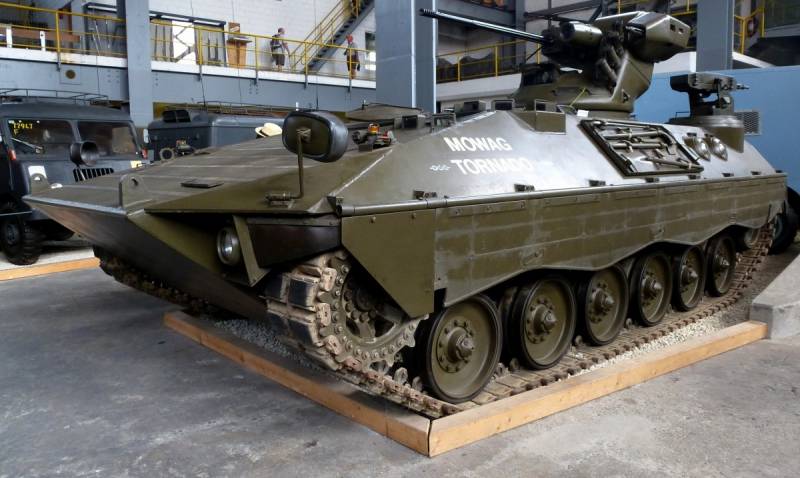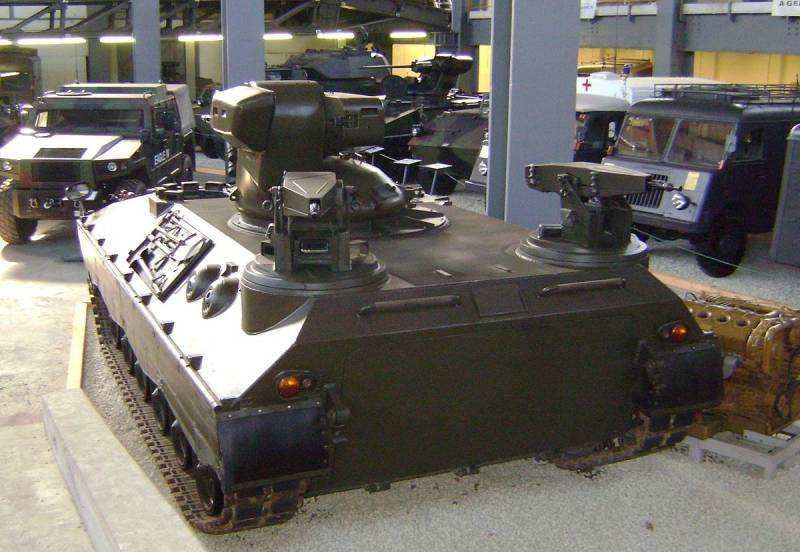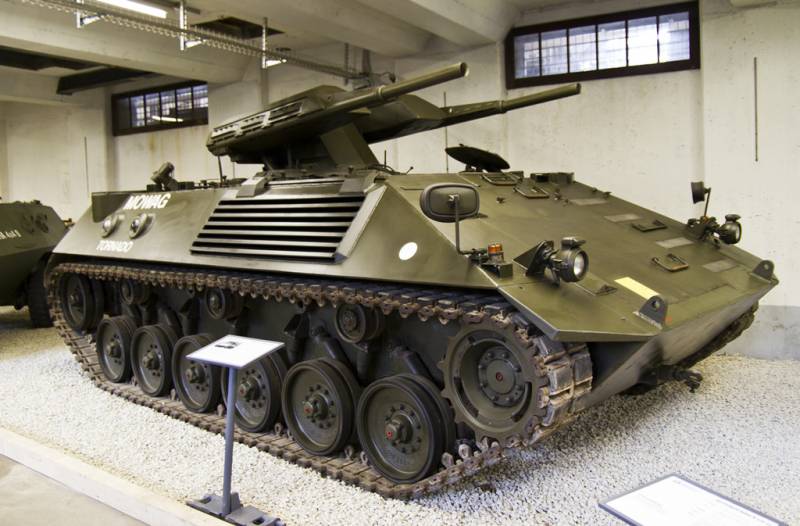Infantry fighting vehicle for the Swiss Alps
The Swiss defense industry is being lost against the backdrop of alpine meadows and valleys framed by high mountains and peacefully grazing cows. However, according to CAST, in the 2015 year, Switzerland exported various weapons worth 1,7 billion dollars, representing 1,8 percent of all shipments weapons on a global scale. The top 100 of the world's largest companies in the military-industrial complex in different years included at least two major Swiss companies - the military-industrial concern RUAG and the aircraft manufacturing company Pilatus Aircraft.
In a small country, most of which is occupied by mountains, there is a aviation industry. Under the Pilatus brand, small PC-12 turboprop multi-purpose aircraft are produced today, which can also be found in Russia, where they are used for inter-regional flights as a small air taxi. There are also PC-21 training aircraft in the company's lineup, which are used by the air forces of Singapore, Switzerland, Australia, Qatar, the United Arab Emirates and other countries. On the basis of this model, light attack aircraft, which can be used as anti-partisan ones, have also been developed. But if it was possible to arrange the production of their own aircraft (there were even attempts to create a jet fighter for their air force) in Switzerland, then with armored vehicles of their own production it somehow did not work. Historically, the main suppliers of armored vehicles for the Swiss army were Germany and Sweden. Currently, all major combat Tanks The Swiss Army is the German Leopard 2 (134 vehicles), and all BMPs are the Swedish CV 9030 and 9030CP (154 + 32 vehicles).
At the same time at different stages of their stories Switzerland tried to develop its own models of armored vehicles. For example, the most famous project of the Swiss main battle tank is the model Neuer Kampfpanzer (NKPz). This tank in the 1980-s, if the project had been completed, would definitely not be lost on the global arms market, but the Swiss military decided to save and not try their luck, preferring the already proven German tank. An example of a distinctive approach to the creation of an infantry fighting vehicle is the experienced infantry fighting vehicle Mowag Tornado, which was the initiative development of the Swiss company Mowag.
It is important to understand that without the influence of the neighbors, this project has not been done either. The Swiss company Mowag was directly involved in the development of the German infantry fighting vehicle Marder, which was considered very successful. At the time of its creation, the German "Kunitsa" was the most protected machine of this class and had a very good speed of movement over rough terrain, easily catching up with the Leopard tanks. Armed with the Bundeswehr, these machines continued to be up to the 2010 year. The Swiss company Mowag took part in their development right up to 1988. For example, the machine-gun installation characteristic of the BMP Marder, located in the aft part of the machine, was developed by Swiss specialists, they wanted to install two such remote-controlled machine guns on their own BMP. Some elements of the "Marten" Swiss actually moved into their combat vehicle infantry "Tornado", which, however, remained in the status of experimental development.
The Mowag Tornado infantry fighting vehicle was developed in the second half of the 1960's. The first prototype was completely ready in 1968. Since the Swiss specialists participated in the development of the German Marder BMP, the machines were very similar even externally, while the Swiss BMP was also created taking into account all the tactical and technical requirements that were presented to the armored vehicles of this type by NATO countries. The layout of the car was traditional, in front of the designers the engine compartment was located (shifted to the right), the fighting compartment was located in the middle of the hull, and the troop compartment was located in the stern, which carried up to 7 infantrymen, the crew of the armored vehicle consisted of three people. In the stern of the BMP there was a reclining ramp, which served to enter and exit the paratroopers from the car, they could also use four hatches located in the roof of the troop compartment. The possibility of firing by a landing force was provided without leaving the combat vehicle; for this, there were two embrasures for small arms on each side in the sides of the troop compartment.
The body of the Swiss BMP was completely welded. In front of the left part was the place of the driver, behind him was the commander of the BMP. The armor of the hull reliably protected the paratroopers, the crew and important components and assemblies of the combat vehicle from bullets and fragments of shells and mines, as well as small-caliber shells. In the frontal projection, the armor provided reliable protection against shelling with various ammunition of caliber 20-25 mm. The front armor plates (upper and lower), as well as the upper part of the onboard armor plates of the hull were located at rational angles of inclination.
The heart of the Tornado infantry fighting vehicle was an eight-cylinder V-shaped diesel engine that developed 287 kW power (390 hp), its power was enough to accelerate a 22 tons fighting vehicle up to a maximum speed of 66 km / h highway). The fuel range did not exceed 400 km. The transmission, engine, and steering mechanism were designed in a single unit. The undercarriage of the Mowag Tornado BMP consisted of six support rollers of medium diameter (rubberized), three supporting rollers, driving (front) and guide (rear) wheels for each board. Suspension traditionally for this type of equipment was made torsion, on the first, second and sixth road wheels there were hydraulic shock absorbers.
The highlight and main feature of the Swiss BMP was a variety of weapons options. Initially, the designers planned to place on the 20-mm machine an automatic cannon installed in a single-seater armored turret of circular rotation, as well as Bantam ATGM (for them there were special attachment points on the tower). This ATGM for its time was quite advanced, providing armor penetration at the level of 500 mm and a firing range of just over two kilometers. The machine gun armament of the BMP was made up of two 7,62-mm machine guns with remote control, which were located in the rear of the hull on special pillars. According to the developers, these machine guns could also be used for firing at air targets, vertical guidance angles ranged from -15 to + 60 degrees, and the horizontal guidance sector was limited to 230 degrees. The ammunition of the machine guns was impressive enough - 5 thousands of rounds of ammunition; for the 20-mm gun it was planned to have 800 shots.
In 1975, the Swiss engineers presented an even more interesting concept by installing a paired installation of Oerlikon Contraves 80-mm recoilless guns on the same chassis. Vertical gun pointing angles ranged from -10 to + 20 degrees. High-explosive fragmentation or cumulative 80-mm missiles with folding stabilizers were used as the main ammunition. Another innovation was the automatic loader and store supply system; there were 8 shells in the stores. Ammunition - 16 shells per barrel. Shooting could be carried out both in single shots and a queue. 8 shells with an initial speed of 710 m / s could be fired in just 1,7 seconds.
Unfortunately for the Swiss industry, the issue of adopting an own-produced infantry fighting vehicle was not resolved, and the Swiss military eventually chose the Swedish BMP CV 9030СН. Despite a number of obvious advantages, Mowag Tornado could not find buyers in the international market either, not least due to the relatively high price. At the same time, Mowag did not abandon attempts to launch its own BMP.
Already in 1990-s, the Swiss designers presented the second version of their BMP, the novelty predictably received the designation Mowag Tornado-2 (after that, the first version automatically became Mowag Tornado-1). The new combat vehicle was distinguished by a more powerful engine, an improved transmission, modern observation devices, and also received a combined sight, allowing you to search for targets not only during the day, but also at night. The main weapon of the updated BMP was to make the 25-mm Oerlikon Contraves automatic cannon, which was planned to be placed either in the overhead armored carriage or in the standard armored turret, Mk.1 and Mk.2, respectively. Options were also considered to increase the combat capabilities of the new product by placing a more powerful 35-mm automatic cannon and installing the Milan ATGM. At the same time, all versions of the BMP were still kept by two remotely controlled machine gun installations in the stern of the machine, which the Swiss designers for some reason could not refuse. But when this attempt led nowhere, Mowag fully concentrated on the development and production of wheeled combat vehicles, and the Mowag Tornado infantry fighting vehicle remained forever in the history of only a few prototypes issued in different years.
In conclusion, we can say that the Mowag wheeled military equipment was much more fortunate. Currently, the 443 armored car MOWAG Eagle of various purpose with the wheel formula 4х4 is in service with the Swiss army. These machines are mass-produced from the 2003 year. Swiss engineers have already released five generations of combat reconnaissance machines MOWAG Eagle, which are successfully sold and for export. For example, Germany is armed with about two times more Eagle armored vehicles than Switzerland, and a large batch of armored vehicles (90 units) is in service with the Danish army.
Information sources:
http://www.dogswar.ru
https://raigap.livejournal.com
http://btvt.info
http://www.libma.ru
Open source materials




Information